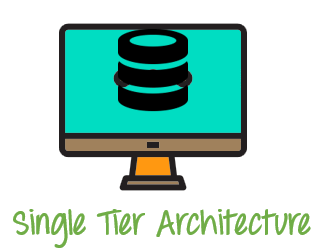What is Parallel Database Architecture?
A Database Architecture is a representation of DBMS design. It helps to design, develop, implement, and maintain the database management system. A DBMS architecture allows dividing the database system into individual components that can be independently modified, changed, replaced, and altered.
A Database stores critical information and helps access data quickly and securely.
- Types of DBMS Architecture
- 1-Tier Architecture
- 2-Tier Architecture
- 3-Tier Architecture
Types of DBMS Architecture
There are mainly three types of DBMS architecture:
- One Tier Architecture (Single Tier Architecture)
- Two Tier Architecture
- Three Tier Architecture
Now, we will learn about different architecture of DBMS with diagram.
1 Tier Architecture in DBMS is the simplest architecture of Database in which the client, server, and Database all reside on the same machine. A simple one tier architecture example would be anytime you install a Database in your system and access it to practice SQL queries.

1 Tier Architecture Diagram
2-Tier Architecture
A 2 Tier Architecture in DBMS is a Database architecture where the presentation layer runs on a client (PC, Mobile, Tablet, etc.), and data is stored on a server called the second tier. Two tier architecture provides added security to the DBMS as it is not exposed to the end-user directly.
In the above 2 Tier client-server architecture of database management system, we can see that one server is connected with clients 1, 2, and 3.
Two Tier Architecture Example:
A Contact Management System created using MS- Access.
3-Tier Architecture
A 3 Tier Architecture in DBMS is the most popular client server architecture in DBMS in which the development and maintenance of functional processes, logic, data access, data storage, and user interface is done independently as separate modules. Three Tier architecture contains a presentation layer, an application layer, and a database server.
3-Tier database Architecture design is an extension of the 2-tier client-server architecture.
- Presentation layer (your PC, Tablet, Mobile, etc.)
- Application layer (server)
- Database Server
The Application layer resides between the user and the DBMS, which is responsible for communicating the user’s request to the DBMS system and send the response from the DBMS to the user.
The goal of Three Tier client-server architecture is:
- To separate the user applications and physical database
- To support DBMS characteristics
- Program-data independence
- Supporting multiple views of the data
Three Tier Architecture Example:
Summary
- An Architecture of DBMS helps in design, development, implementation, and maintenance of a database
- The simplest database system architecture is 1 tier where the Client, Server, and Database all reside on the same machine
- Three-tier client-server architecture consists of the Presentation layer (PC, Tablet, Mobile, etc.), Application layer (server) and Database Server
